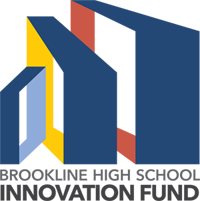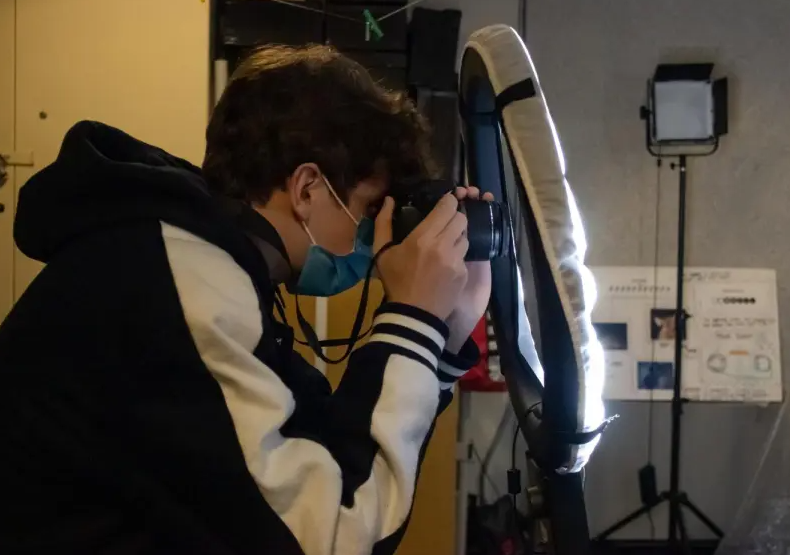
The surge of the COVID-19 Omicron wave is threatening to shut down many businesses and school events. Despite the surge, Brookline Lens is adapting as they persist to fulfill their clients’ requests.
Launched in the fall of 2019, Brookline Lens is an optional semester or full year course which provides students the opportunity to produce free photo and video projects for the high school and the greater Brookline community.
These projects include an informational video on Tappan Green, a mini documentary for the Brookline Recreation Center and a video for the PTO.
On Jan. 12, Brookline Lens had to cancel their launch party for the second time in a row due to issues with COVID-19.
IMG_3984Gallery • 4 Photos
Bezawit O’Neill, a junior who is one of the project managers, said that the launch party was meant to advertise Brookline Lens to students interested in joining and future clients who may want their services.
“I was part of the group that was in charge of the slideshow presentation,” O’Neill said. “If people wanted some project done or seniors wanted their senior portraits, it was supposed to be an outreach for them to know that Brookline Lens is there to provide that help if they needed it.”
Lori Lynn, a teacher for the course, said it is difficult to plan a virtual launch party event because it was challenging enough to produce the projects.
“We really feel like it’s something that will be better in person. So this year, we’re attempting to do it. It’s tricky because we’re prioritizing our projects for clients,” Lynn said. “But we hope in the future to have some kind of in-person event where people can meet us and learn about what we do.”
Thato Mwosa, another teacher of Brookline Lens, said she hopes to reschedule and plan the in-person event when Omicron dies down.
“We feel like the next couple of months is really for promoting the things that we’ve always wanted to do,” Mwosa said. “We’re going to launch and make sure that people know that we exist, that we’re a great class and we offer students a great opportunity for hands-on learning and to contribute to the community.”
To compensate for the lack of a launch party, Brookline Lens has found other avenues to advertise. Students in the social media team and marketing and advertising team have been working closely to promote Brookline Lens on Instagram, Facebook, Tiktok and Twitter, while the website management team has been organizing Brookline Lens website.
“We are thinking of ways that we can advertise what we do and get the word out,” Lynn said. “We want people to know that if they have a project in mind or need help with photos or videos, they can come to us. We’re getting there. But I think there’s still a lot of people that need to learn about us.”
Senior Kamini Bhadauria, a student in Brookline Lens, said COVID-19 caused delays in her project.
“It has slowed down the process of the projects. We’re heading into filming our Brookline Rec video project, but because of COVID-19, we’re very unsure about when we’ll be able to film and interview people,” Bhadauria said.
Despite COVID-19 affecting the students’ experiences in Brookline Lens, students said they are glad that they are able to learn about photography, filmmaking and how to communicate with clients.
“It’s a great experience that you can use in any field that you’re going to do when you move on with different levels of high school or also college,” O’Neill said. “I think for any student, if you have any interest in filmmaking or photography, or even if you don’t and you just want to experience something new, I’d definitely say Brookline Lens is a great experience.”
Lynn and Mwosa said they hope that Brookline Lens grows and that they can be a pillar for those who may need their services.
“We have so much potential, and we hope that more and more people come to us,” Mwosa said. “We want people to just know that we’re here to help and understand that when they come to us, they’re also giving students an opportunity to learn, to work with clients and to develop their skills.”
Brookline Lens provides clients with free photography or videography services. Clients can offer to pay a stipend. To request their services, reach them at brooklinelens@gmail.com or at their website Photo Video Productions House | The Brookline Lens | United States
Brookline Lens seeks to be flexible amid COVID-19 issues and cancellations
Allen Yu, Staff Writer|January 25, 2022
PHOTO CONTRIBUTED BY LORI LYNN AND THATO MWOSA
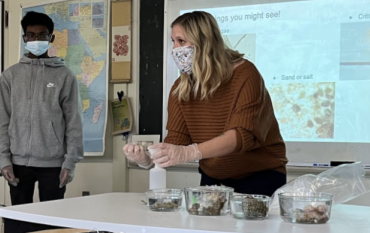
Students learned about the threat of microplastics in the environment and specifically in water supplies with a lab on Nov. 15.
Four thousand miles is not enough to stop the Global Leadership class from connecting with Brookline’s sister city, Quezalguaque, Nicaragua.
Global Leadership aims to help students gain more experience and knowledge in solving world issues. On Jan. 31, they will begin the Tap Challenge, which lasts for 10 days and encourages students to use reusable water bottles instead of plastic, single-use ones.
Global Leadership teacher Roger Grande said before the start of the Tap Challenge, students learned about Quezalguaque and its specific water-related needs.
“We learned about their water insecurity: that many people in one of the hemisphere’s poorest nations do not have regular and easy access to potable, clean water,” Grande said.
Junior and Global Leadership student Agnes Shales said although Brookline and Quezalguaque are many miles away from one another, the Tap Challenge brings the two together. Money donated to the Tap Challenge will be given to a fund in Quezalguaque to help with their water security efforts.
“We’re a city in possibly one of the areas of the world with the best water. We are so incredibly lucky that we aren’t forced to pay for water in the same way that they do there,” Shales said. “As their sister city, we can take responsibility for improving the planet and helping out. We try to do this by reducing our use of plastic water bottles because it’s an example of our privilege, damaging the Earth in ways we don’t need to be.”
Junior and Global Leadership student Zoe Raybould said the Tap Challenge allows students to practice leadership skills as they each have individual roles.
“We’re learning to be leaders on a global scale and to have the outreach that affects people all over the world, not just in our small community. But at the same time, we want to make a real difference in both of our communities,” Raybould said.
Shales said the Tap Challenge permits her to help another community while honing leadership skills for the Global Leadership class.
“We are a class that focuses on development and leadership skills and issues facing the international community. I think that finding a way in which our lives tie into that, through the sister city project, is a super interesting take on that,” Shales said. “Usually projects are about areas that we didn’t have a real impact on before. I think this is a way to make an impact through the global lens that we’ve been trying to cultivate in our class.”
The Global Leadership class conducted a lab with the help of two Boston University graduate students, Caroline Fleming and Jenna Rindy, on Nov. 15. The lab centered around small plastic debris called microplastics and their negative role in the environment.
Rindy introduced the microplastics lab by explaining how chemicals enter the environment through plastics not being disposed of properly.
“Plastics are made of chemicals and as they get exposed to things like rain, they release chemicals into our environment. A lot of those chemicals are really toxic,” Rindy said. “The issue is that they can enter our soils and be really harmful for what grows and lives there. These plastics are also harmful for animal life, land and sea.”
According to Grande, the purpose of the microplastics lab was to demonstrate the danger plastics pose to coral, which connects back to the Tap Challenge.
Junior and Global Leadership student Dan Hernan said that the microplastics lab prepared students for the Tap Challenge because they learned about microplastics’ harm to the environment.
“The microplastics lab we did was almost like a smaller version of what we’re going to do with the Brookline High School community,” Hernan said. “It was bringing awareness to students in the class about the prevailing and dangerous force of microplastics in our own water supply.”
Audrey Garon, DEI Editor|January 21, 2022
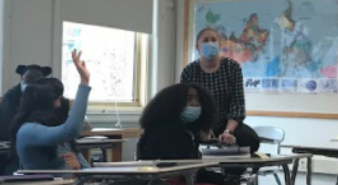
Students in Racial Awareness understand the importance of engaging in conversations about race at the high school, as this influenced their application.
Senior Elliot Lazarova-Weng applied for Racial Awareness because he believed a course centered around conversations about race was necessary to his education. He also noticed a disturbing absence of these discussions within the mainstream curriculum. Yet, the course fell short of what he had envisioned.
Currently the course is led by math teacher Hayley Wells and science teacher Karen Wong. As outlined in the syllabus, the goal of the seminar is to explore the complexities of race and racism, yet Wong has a slightly smaller personal objective.
“At the end of the year, I just really want to see that students have gained just a little bit more knowledge and a little bit more awareness than they had in September,” Wong said.
As discussions surrounding race continue to be integrated into the school’s curriculum, some faculty have discussed making Racial Awareness a graduation requirement. Wong confirmed that this has been an ongoing conversation within the administration. She said that this addition would not happen in the near future.
Racial Awareness is an elective course where a group of sophomores, determined through an application process, explore the prevalence of race within national, local and high school communities.
Founder and METCO Coordinator Malcolm Cawthorne originally thought of the course while taking a professional development class on race and equity. This resulted in a new revelation for Cawthorne.
“I realized in my classes that there wasn’t a lot of structured space for kids to have conversations around race. My feeling was that kids actually really wanted to have those conversations,” Cawthorne said. “I think more importantly they wanted to have some type of structure. One of the scary things when talking about race is that people are afraid of saying the wrong thing. But if there’s a teacher there, if there’s a structure there, that provides a sense of security for some.”
Years after Cawthorne led the course and new teachers have taken over, seniors Lily Lockwood and Alejandra Mineo-Levitsky said the class might no longer achieve Cawthorne’s goal. Lockwood said many students don’t elect to take the course with the same intentions, which thoroughly affected the culture within the classrooms.
“I think a lot of people took it because of the free blocks and the field trips, and because it would make them look good, not because they actually cared,” Lockwood said.
Mineo-Levitsky said students of color, including herself, were disproportionately targeted to be used as facilitators.
Mineo-Levitsky shared that as a Latina person, she felt much of her time was spent educating her peers.
“It felt like for me, as a Latina, a lot of the time was not really spent in a positive way for myself. It was mostly educating other people, which was not really what I signed up for,” Mineo-Levitsky said.
Lazarova-Weng said he found that class discussions often didn’t go past surface level when exploring race. He observed that the class catered more towards protecting Caucasian students’ comfort.
“In terms of race, you are never going to feel comfortable so long as you’re actually talking about it. I don’t think that it’s a topic you can explore and learn about without being uncomfortable. But I think that’s the whole thing with BHS. They always want to build safe environments,” Lazarova-Weng said.
Sophomore Ivy Fawcett, a current student in Racial Awareness, said she is experiencing a positive atmosphere in her classroom. Fawcett said a culture has developed where students are able to have differing opinions and educate each other as well as themselves.
“Personally, I’ve always felt like I’ve been able to speak my mind. I know that if I say something incorrect or that doesn’t align with someone else’s ideas, someone will correct me or at least do a good job of staying kind,” Fawcett said. “I personally believe that it should be mandatory, because I’ve learned so much from it.”
Lazarova-Weng said for any requirement to happen he thinks there needs to be more focus on how the course may affect students of color.
“While I think it’s important to have courses like this, if we were to make it mandatory, there are students who have gone through trauma surrounding their race, who do not want to go into school and have to relive that. I think it needs to be a choice whether you want to deal with that in school or not. Especially for students of color, some people just want to go to school and be able to forget and focus on their learning,” Lazarova-Weng said.
Lockwood said she had conflicting ideas about the class being required. She said while the content was important to learn, the element of it being a choice was a key component.
“If you force people who don’t actually care, who don’t actively want to learn, then you have such an unhealthy class environment, and you don’t actually learn any of the things that you’re trying to emphasize,” Lockwood said.
Racial Awareness class sparks conversation
Molly Louison, Staff Writer|January 9, 2022
KYLA FREY/SAGAMORE STAFF
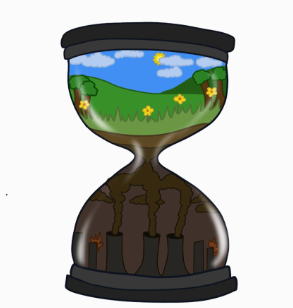
Roger Grande and Briana Brown have worked together to design a course that helps students fight climate change through both scientific and historical education.
Only 42 percent of teachers across the country are teaching about climate change, according to a NPR poll from 2019. However, science teacher Briana Brown and history teacher Roger Grande are pioneering climate change education at the high school with their new class on climate science and social change.
Brown and Grande started teaching the new Climate Science and Social Change class this fall. The class addresses the urgency of climate action: it gives students the political skills to make change in the community and a richer understanding of the climate crisis by covering historical and scientific content.
The class is the product of frustration from both teachers who are passionate about helping younger generations fight for their future. Brown said she was losing hope after teaching about climate change in her science classes for 12 years without significant change in the news.
“Collectively as a species, we really have not done anything that we need to do. There’s a little progress here and there. I was starting to feel really pessimistic,” Brown said.
Grande said he felt a personal sense of urgency in combating climate change.
“I think about how [my daughter’s] future is going to be a very different experience than my life so far and climate change is a major driver of disruption that she’ll be experiencing,” Grande said.
Brown said that the class develops both scientific and political skills. On some days, students learn about the science behind climate change’s effects while on others, they learn tactics to convince lawmakers to make policy changes.
“We really want to approach climate science from multiple dimensions,” Brown said.
Senior and student in the class, Evan Guttel, said the Climate Science and Social Change class is unlike any other class he has taken because of its historical and scientific duality.
“I think even in a town like Brookline where a lot of people are very cognizant of the issues surrounding climate change, having a class on it is very necessary and applicable because it’s going to affect all of our lives,” Guttel said.
According to Brown and Grande, climate change requires social action so teaching political skills is necessary to tackle the climate crisis.
“It’s not about the science that’s going to persuade people: it’s the politics,” Grande said.
From the class, Grande said he wants students to have a solid understanding of the science behind climate change as well as the skills to talk about it in a more political setting.
“I want students to become confident and competent climate communicators,” Grande said.
Both Grande and Brown are working hard to increase their influence on the community through training activists who can educate the school community on the climate crisis.
“I feel better that I’m going to be training people to be activists for change,” Brown said. “I can magnify my impact because hopefully a few people at least will go out into the world and start to do these actions that need to be done.”
Lia Fox, Staff Writer|November 13, 2021
GRAPHIC BY LIA FOX
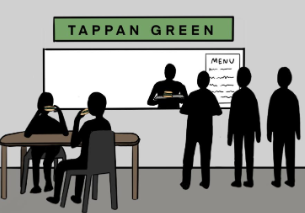
The school restaurant will reopen in the fall of 2021 with the name Tappan Green.
The mouthwatering scents of freshly made food from Restaurant 108 have long been absent from the school hallways. Amidst the many challenges brought on by the pandemic and school construction, the high school’s student-run restaurant has endured a long period of uncertainty.
Preparations for the new restaurant are currently underway, with plans to present opportunities for learning through revised culinary courses and a wide range of new food choices for students. According to Career and Technology Education Curriculum Coordinator Brittany Stevens, the school restaurant, with the new name Tappan Green, will return next year.
“The restaurant went on hiatus this year, in part because of the new space being built and in part because of a teacher’s retirement and the pandemic,” Stevens said. “What’s been happening behind the scenes is that a group of us are planning to reopen the restaurant with a new look and feel.”
Construction for the new restaurant space is scheduled to be completed in July of 2021, but students and staff have already been preparing for the opening of the restaurant in the fall.
Culinary teacher Elizabeth Ricardelli said Tappan Green will open with many changes, including a focus on rebranding.
“Nothing is a hundred percent set in stone. I’m excited for all the planning that’s going around it. I think that there’s so much we can do.” Ricardelli said.
Sophomore Martha Bialek is among a group of students currently helping Ricardelli with efforts to experiment with possible menu items.
“We are trying to make up new recipes for when we do get to work in the new kitchen. Every recipe is split into two weeks. One Wednesday we’ll talk about what works together, what recipes we think are good and we’ll test them,” Bialek said. “The next week, we’ll ask teachers if they want to try the food we’ve settled on to make. Then, they’ll give us feedback on what’s good or not.”
Other than the rebranding of the restaurant and a new menu, Ricardelli said the culinary teachers are revising the course sequence offered to students involved in running the restaurant.
“We are working towards creating a program where students can learn how to cook and run a restaurant, all aspects of it,” Ricardelli said. “We’d like to have the restaurant follow a pathway so that students could get the necessary experience they would need if they wanted to go on to culinary school or have a career in the industry.”
Stevens said the restaurant courses previously offered were very different from the restaurant pathway that will be available for students to take next year.
“As it has historically existed, the restaurant was focused on teaching students cooking skills. You sign up to be in the restaurant class, and you learn to work the point of sale, help customers, and make food,” Stevens said. “In our reimagining, our ultimate goal is to break down the wall between the restaurant as a class and the restaurant as a business.”
According to Stevens, the restaurant pathway presents multiple real world learning opportunities for students to expand their knowledge of running a business.
“We’ll talk about all of the things that real restaurants talk about in terms of how we’ll create a brand identity so we are recognizable to people in the school. Those are things we’re going to hope that students will help us with,” Stevens said. “We want to get students involved in thinking about the menu items we should offer, local vendors we could get stuff from, how to price items, and learning about trends in the restaurant industry.”
Stevens said culinary teachers are prepared to bring students into the fold of making management decisions for Tappan Green as the pathway launches soon.
“It’s been a few years since we’ve had a core base of students working there, but once we started to have students who’ve been with us for a couple years, we want them to show us how they want to learn from the restaurant,” Stevens said. “It’s a lot of exciting work, and we’re just going to take baby steps. Next year, you’ll see us open with a pretty standard menu. Then, each year after that you’re going to see us expanding.”
Kyla Frey, News Editor|July 2, 2021
GRAPHIC BY ELSIE MCKENDRY
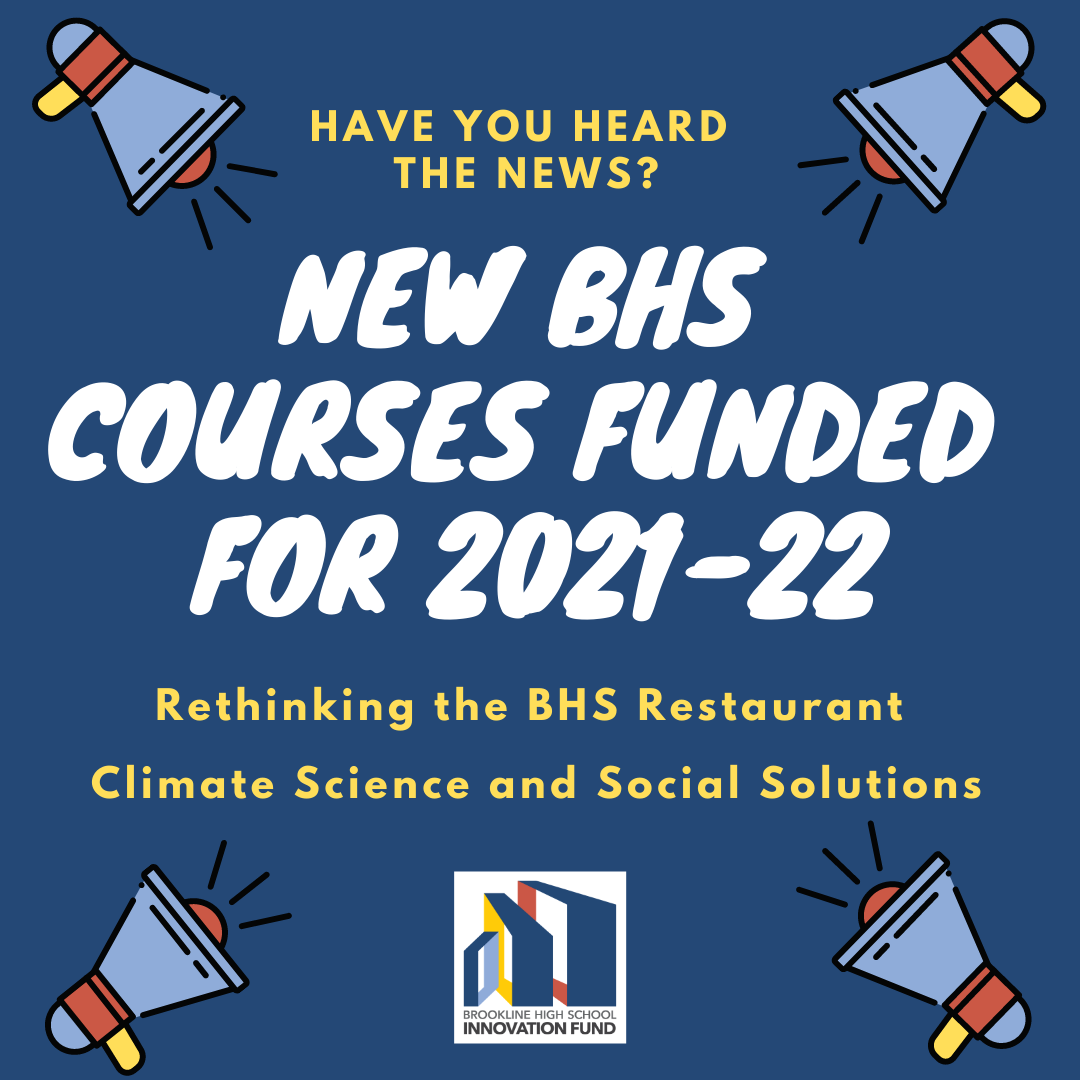
We are excited to announce upcoming investments in teaching and learning at BHS: two brand new courses will launch, four courses will continue through their final year of funding, and faculty will have the opportunity to reflect on pedagogy in the pandemic year at an upcoming summer summit. We are grateful to our generous donors whose support enables us to work with BHS leadership and faculty to fund these important programs.
Rethinking the Restaurant: Creating Community through Social Impact (NEW COURSE)
$66,000 Year One Investment
Rethinking the BHS restaurant will integrate the program more cohesively into curricular and co-curricular experiences for the entire BHS community, with students taking the lead in running its business operations in meaningful and creative ways. Faculty are excited by the multifaceted opportunities for innovation where the restaurant has potential as a lab for interdisciplinary learning with a social impact lens. For example, the restaurant could be a place where English Language Learners could introduce dishes from their home cultures as a special menu item; World Language teachers and students could work with the culinary program to design “take-over” menus for cultural observations or holidays; and students in Social/Food Justice or Environmental Action clubs could team with our culinary program to understand and improve how to sustainably run our business. Rethinking the Restaurant opens up outstanding experiential learning opportunities for students not only in the restaurant itself, but also for a diverse range of students in clubs, courses, and throughout the campus.
Faculty lead: Britt Stevens, Chair, Department of Career and Technical Education
Climate Science and Social Solutions (NEW COURSE)
$43,000 Year One Investment
Climate Science and Social Solutions is an interdisciplinary team-taught elective with instruction from both the scientific and historical perspectives. The course will enable students to engage in project-based learning by analyzing real world policy options related to climate change, and then research and posit definable and effective solutions. The goal is to have seniors engage in advocacy campaigns designed to shape perceptions on climate change and encourage personal mitigation strategies.
Faculty leads: Briana Brown (Science) and Roger Grande (Social Studies)
Faculty COVID-19 Reflection Summit
$10,000 for BHS faculty to convene this summer to reflect on lessons learned through the pandemic and how their important work funded by our COVID-19 Teaching and Learning Response Grants this year can inform pedagogy for 2021-22.
Continued Funding for Ongoing Courses
$186,000 for continued funding for four pilot programs through their final year in 2021-22: Experiential Physics for Ninth Grade; Brookline Lens; Hub; and Coding @BHS. Learn more about these programs here.
Read more about the impact of these investments in our June 2021 Letter from the Chair
Page 4 of 11« First«...23456...10...»Last »

